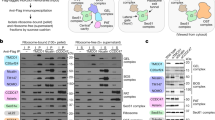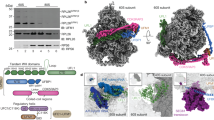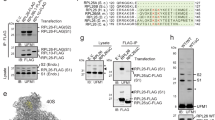Abstract
ERj1p is a membrane protein of the endoplasmic reticulum (ER) that can recruit the ER lumenal chaperone BiP to translating ribosomes. ERj1p can also modulate protein synthesis at initiation and is predicted to be a membrane-tethered transcription factor. Here we attribute the various functions of ERj1p to distinct regions within its cytosolic domain. A highly positively charged nonapeptide within this domain is necessary and sufficient for binding to ribosomes. Binding of ERj1p to ribosomes involves the 28S ribosomal RNA and occurs at the tunnel exit. Additionally, ERj1p has a dual regulatory role in gene expression: ERj1p inhibits translation in the absence of BiP, and another charged oligopeptide within the cytosolic domain of ERj1p mediates binding of the nuclear import factor importin β and import into the nucleus, thereby paving the way for subsequent action on genomic DNA.
This is a preview of subscription content, access via your institution
Access options
Subscribe to this journal
Receive 12 print issues and online access
$189.00 per year
only $15.75 per issue
Buy this article
- Purchase on Springer Link
- Instant access to full article PDF
Prices may be subject to local taxes which are calculated during checkout








Similar content being viewed by others
References
Palade, G. Intracellular aspects of the process of protein synthesis. Science 189, 347–358 (1975).
Blobel, G. & Dobberstein, B. Transfer of proteins across membranes. J. Cell Biol. 67, 835–851 (1975).
Görlich, D. & Rapoport, T.A. Protein translocation into proteoliposomes reconstituted from purified components of the endoplasmic reticulum membrane. Cell 75, 615–630 (1993).
Walter, P. & Blobel, G. Disassembly and reconstitution of signal recognition particle. Cell 34, 525–533 (1983).
Potter, M.D., Seiser, R.M. & Nicchitta, C.V. Ribosome exchange revisited: a mechanism for translation- coupled ribosome detachment from the ER membrane. Trends Cell Biol. 11, 112–115 (2001).
Möller, I. et al. A general mechanism for regulation of access to the translocon: competition for a membrane attachment site on ribosomes. Proc. Natl. Acad. Sci. USA 95, 13425–13430 (1998).
Brodsky, J.L., Goeckeler, J. & Schekman, R. BiP and Sec63p are required for both co- and posttranslational protein translocation into the yeast endoplasmic reticulum. Proc. Natl. Acad. Sci. USA 92, 9643–9646 (1995).
Dierks, T. et al. A microsomal ATP-binding protein involved in efficient protein transport into the mammalian endoplasmic reticulum. EMBO J. 15, 6931–6942 (1996).
Young, B.P., Craven, R.A., Reid, P.J., Willer, M. & Stirling, C.J. Sec63p and Kar2p are required for the translocation of SRP-dependent precursors into the yeast endoplasmic reticulum in vivo. EMBO J. 20, 262–271 (2001).
Nicchitta, C.V. & Blobel, G. Lumenal proteins of the mammalian endoplasmic reticulum are required to complete protein translocation. Cell 73, 989–998 (1993).
Tyedmers, J., Lerner, M., Wiedmann, M., Volkmer, J. & Zimmermann, R. Polypeptide chain binding proteins mediate completion of cotranslational protein translocation into the mammalian endoplasmic reticulum. EMBO Rep. 4, 505–510 (2003).
Wirth, A. et al. The Sec61p complex is a dynamic precursor activated channel. Mol. Cell 12, 261–268 (2003).
Liao, S., Lin, J., Do, H. & Johnson, A.E. Both lumenal and cytosolic gating of the aqueous ER translocon pore are regulated from inside the ribosome during membrane protein integration. Cell 90, 31–42 (1997).
Hamman, B.D., Hendershot, L.M. & Johnson, A.E. BiP maintains the permeability barrier of the ER membrane by sealing the lumenal end of the translocon pore before and early in translocation. Cell 92, 747–758 (1998).
Alder, N.N., Shen, Y., Brodsky, J.L., Hendershot, L.M. & Johnson, A.E. The molecular mechanism underlying BiP-mediated gating of the Sec61 translocon of the endoplasmic reticulum. J. Cell Biol. 168, 389–399 (2005).
Ma, Y. & Hendershot, L.M. The unfolding tale of the unfolded protein response. Cell 107, 827–830 (2001).
Zhang, K. & Kaufman, R.J. Signaling the unfolded protein response from the endoplasmic reticulum. J. Biol. Chem. 279, 25935–25938 (2004).
Brightman, S.E., Blatch, G.L. & Zetter, B.R. Isolation of a mouse cDNA encoding MTJ1, a new murine member of the DnaJ family of proteins. Gene 153, 249–254 (1995).
Dudek, J. et al. A novel type of cochaperone mediates transmembrane recruitment of DnaK-like chaperones to ribosomes. EMBO J. 21, 2958–2967 (2002).
Chevalier, M., Rhee, H., Elguindi, E.C. & Blond, S.Y. Interaction of murine BiP/Grp78 with the DnaJ homologue Mtj1. J. Biol. Chem. 275, 19620–19627 (2000).
Kroczynska, B., Evangelista, C.M., Samant, S.S., Elguindi, E.C. & Blond, S.Y. The SANT2 domain of murine tumor cell DnaJ-like protein 1 human homologue interacts with α1-antichymotrypsin and kinetically interferes with its serpin inhibitory activity. J. Biol. Chem. 279, 11432–11443 (2004).
Zupicich, J., Brenner, S.E. & Skarnes, W.C. Computational prediction of membrane-tethered transcription factors. Genome Biol. 2, 50.1–50.6 (2001).
Beckmann, R. et al. Architecture of the protein-conducting channel associated with the translating 80S ribosome. Cell 107, 361–372 (2001).
Spahn, C.M.T. et al. Structure of the 80S ribosome from Saccharomyces cerevisiae tRNA-ribosome and subunit-subunit interactions. Cell 107, 373–386 (2001).
Christiansen, J., Egebjerg, J., Larsen, N. & Garret, R.A. Analysis of rRNA structure: experimental and theoretical considerations. in Ribosomes and Protein Synthesis: A Practical Approach (ed. Spedding, G.) 229–252 (IRL Press, Oxford, 1990).
Blau, M. et al. ERj1p uses a universal ribosomal adaptor site to coordinate the 80S ribosome at the membrane. Nat. Struct. Mol. Biol. advanced online publication 23 October 2005 (10.1038/nsmb998).
Halic, M. et al. Structure of the signal recognition particle interacting with the elongation-arrested ribosome. Nature 427, 808–814 (2004).
Tyedmers, J. et al. Homologs of the yeast Sec complex subunits Sec62p and Sec63p are abundant proteins in dog pancreas microsomes. Proc. Natl. Acad. Sci. USA 97, 7214–7219 (2000).
Thomas, Y., Bui, N. & Strub, K. A truncation in the 14 kDa protein of the signal recognition particle leads to tertiary structure changes in the RNA and abolishes the elongation arrest activity of the particle. Nucleic Acids Res. 25, 1920–1929 (1997).
Spedding, G. Isolation and analysis of ribosomes from prokaryotes, eukaryotes, and organelles. in Ribosomes and Protein Synthesis: A Practical Approach 1–29 (IRL Press, Oxford, 1990).
Greiner, M., Caesar, S & Schlenstedt,, G. The histones H2A/H2B and H3/H4 are imported into the yeast nucleus by different mechanisms. Eur. J. Cell Biol. 83, 511–520 (2004).
Acknowledgements
The plasmid that encodes GST-fusion mouse importin α and β was kindly provided by K. Weis (University of California, Berkeley, California, USA); yeast Ran was kindly donated by G. Schlenstedt (Universität des Saarlaudes, Homburg, Germany). We thank M. Albrecht and C. Völzing for help with bioinformatic analyses, to E. Herrmann for help with the statistical analysis and M. Lerner, S. Oberhauser and P. Scholtes for technical assistance. This work was supported by grants from the Deutsche Forschungsgemeinschaft, the Universität des Saarlandes and the Fonds der Chemischen Industrie.
Author information
Authors and Affiliations
Corresponding author
Ethics declarations
Competing interests
The authors declare no competing financial interests.
Supplementary information
Supplementary Fig. 1
In vitro protein synthesis is affected by different derivatives of WT 17-mer ERj1p to different extents. (PDF 127 kb)
Supplementary Fig. 2
The ribosome binding of ERj1C-ΔC85 and ERj1p, respectively, is not affected by BiP and BiP-R197H, respectively. (PDF 41 kb)
Supplementary Table 1
The oligopeptide motifs that are responsible for arrest of translation and nuclear import are distinct (PDF 4 kb)
Supplementary Table 2
The translational arrest activity of ERj1p but not the ribosome binding activity is suppressed by BiP: role of the J-domain (PDF 4 kb)
Supplementary Table 3
Highly charged oligopeptides that are present in various ligands of ribosomes (PDF 6 kb)
Rights and permissions
About this article
Cite this article
Dudek, J., Greiner, M., Müller, A. et al. ERj1p has a basic role in protein biogenesis at the endoplasmic reticulum. Nat Struct Mol Biol 12, 1008–1014 (2005). https://doi.org/10.1038/nsmb1007
Received:
Accepted:
Published:
Issue Date:
DOI: https://doi.org/10.1038/nsmb1007
This article is cited by
-
Substrate-driven assembly of a translocon for multipass membrane proteins
Nature (2022)
-
Dual topology of co-chaperones at the membrane of the endoplasmic reticulum
Cell Death Discovery (2021)
-
Sec62 promotes pro-angiogenesis of hepatocellular carcinoma cells under hypoxia
Cell Biochemistry and Biophysics (2021)
-
Sec62 promotes early recurrence of hepatocellular carcinoma through activating integrinα/CAV1 signalling
Oncogenesis (2019)
-
Inhibitors of protein translocation across membranes of the secretory pathway: novel antimicrobial and anticancer agents
Cellular and Molecular Life Sciences (2018)



